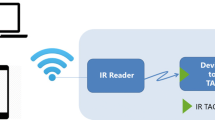Abstract
In this study, we present a novel approach for continuous detection, localization, and identification of parcels and bins in automated facility logistics systems. It presents a distinct departure from the traditional system design: light barriers and barcode readers are substituted by low-cost cameras and few RFID readers. By combining vision-based systems and RFID systems, this approach can compensate for the drawbacks of each respective system. For example, only the vision system is used for localization. The main part of our paper describes computer-graphics methods specific to the given problem to both track and read visual markers attached to parcels or bins. In addition, we use information from the RFID system to narrow the decision space for detection and identification. From an economic point of view, this approach can lower the costs of changing a material flow system.









Similar content being viewed by others
References
De Meyer A (1998) Manufacturing operations in Europe: where do we go next?. Eur Manage J 16(3):262–271
Schuh G, Wemhöner N, Friedrich C (2006) Scenario-based lifecycle analysis of manufacturing systems. CIRP—J Manuf Syst 35(2)
Nopper J, ten Hompel M (2009) Analysis of the relationship between control strategy, layout complexity and performance in facility logistics. In: POMS 20th Annual Conference
Nyhuis P, Wiendahl H (2006) Logistic production operating curves basic Model of the theory of logistic operating curves. CIRP Ann—Manuf Technol 55(1):441–444
Fleisch E, Mattern F (eds) (2005) Das Internet der Dinge Ubiquitous Computing und RFID in der Praxis. Springer, Berlin
Floerkemeier C, Langheinrich M, Fleisch E, Mattern F, Sarma SE (eds) (2008) The internet of things. First international conference, IOT 2008, Zurich, Switzerland, March 26–28. Springer
Sarma S, Brock DL, Ashton K (2000) The networked physical world, proposals for engineering the next generation of computing, commerce & automatic-identification. Tech. rep., MIT Auto-Id Center
Bullinger HJ, ten Hompel M (2007) Internet der Dinge. Springer, Berlin
ten Hompel M, Schmidt T (2008) Warehouse management. Springer, Berlin
Isard MAB (2004) CONDENSATION—conditional density propagation for visual tracking. Int J Comput Vis Springer-Verlag 29(1):5–28
Porikli F (2005) Integral histogram: a fast way to extract histograms in cartesian spaces. IEEE Comput Soc Conf Comput Vis Pattern Recognit, CVPR’05 1:829–836
Norm ISO/IEC 16022 2006 (2006) Information technology—Automatic identifcation and data capture techniques—Data matrix bar code symbology specification
Norm ISO/IEC 18004 2006 (2006) Information technology—Automatic identifiation and data capture techniques—QR Code 2005 bar code symbology specification
Brock D (2001) The electronic product code (EPC)—A naming scheme for physical objects. MIT AUTO-ID Center, Massachusetts Institute of Technology
Strassner M, Fleisch E (2005) Innovationspotenzial von RFID fnr das supply-chain-management. Wirtschaftsinformatik 47(1):45–54
PARIFLEX—Passive RFID application with a flexible bistable display, no. 19 in Clolloque International ‘Optique Hertzienne Dielectrique’ (2007)
Vogendes T, Bartram T (2007) Rewe group erporbt RFID gemeinsam mit der supply chain für Frische. GS1 Magazin 2:32–34
Wessel R (2009) Rewe developing long-range real-time location RFID system. In: RFID Journal. http://www.rfidjournal.com/article/view/5187. Accessed 28 Nov 2009
RFID—Anwendungsbeispiel Volkswagen AG (2006) http://www.rfidatlas.de/images/stories/RFID_Fallstudien/vw_april2006.pdf. Accessed 28 Nov 2009
RFID Business Case For Bagging Tagging. IATA (2007) http://www.iata.org/NR/rdonlyres/99091491-CB49-4913-BAB4-EA578CA814CC/0/RFIDforbaggagebusinesscase21.pdf. Accessed 28 Nov 2009
VDI 4472-1 (2006) Requirements to be met by transponder systems for use in the supply chain. Beuth Verlag
LANDMARC: indoor location sensing using active RFID (2003) Proceedings of the first IEEE international conference on pervasive computing and communications, PerCom 2003
Bechteler T, Yenigün H (2003) 2-D localization and identification based on SAW ID-tags at 2.5 GHz. IEEE Trans Microw Theory Tech LNCS 51(5):1584–1590
Mojix EPC Compliant Real-Time Location System (2009). http://www.mojix.com/products/documents/RTLS_brochure.pdf. Accessed 28 Nov 2009
Linde H (2006) On aspects of indoor localisation. Ph.D. thesis, Technical University Dortmund
Yilmaz A, Javed O, Shah M (2006) Object tracking: a survey. ACM Comput Surv (CSUR) 38(4)
Karaca HN, Akinlar C (2005) A multi-camera vision system for real-time tracking of parcels moving on a conveyor belt. Lecture Notes in Computer Science. Springer-Verlag 3733:708–717
Siemens Technical Press IS (2009) Vereinzelung auf kleinstem Raum mit dem Visicon Singulator von Siemens. http://www.siemens.com/press/de/pressemitteilungen/2009/mobility/imo200901008.htm. Accessed 28 Nov 2009
Gonzalez R, Woods R (2008) Digital image processing, 3 edn. Prentice Hall International, UK
Keller S, Lauze F, Nielsen M (2008) Deinterlacing using variational methods. IEEE Trans Image Process 17(11):2015–2028
Thrun S, Burgard W, Fox D (2005) Probabilistic robotics. The Mit Press, Cambridge
Bhattacharyya A (1943) On a measure of divergence between two statistical populations defined by probability distributions. Bull Calcutta Math Soc 35:99–109
Tukey J (1977) Box-and-Whisker plots. Exploratory data analysis. Addison-Wesley, Reading, pp 39–43
Bookstein A, Kulyukin V, Raita T (2002) Generalized hamming distance. Inf Retr 5(4):353–375
Author information
Authors and Affiliations
Corresponding author
Rights and permissions
About this article
Cite this article
Weichert, F., Fiedler, D., Hegenberg, J. et al. Marker-based tracking in support of RFID controlled material flow systems. Logist. Res. 2, 13–21 (2010). https://doi.org/10.1007/s12159-010-0025-6
Received:
Accepted:
Published:
Issue Date:
DOI: https://doi.org/10.1007/s12159-010-0025-6




